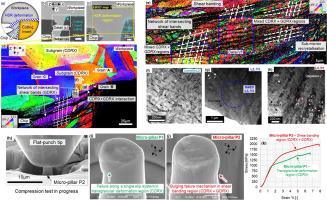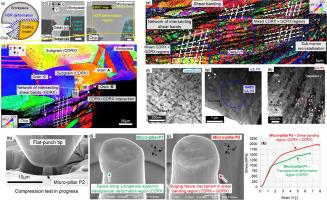镍基高温合金高应变速率变形中连续和几何动态再结晶的相互作用和竞争
IF 9.3
1区 材料科学
Q1 MATERIALS SCIENCE, MULTIDISCIPLINARY
引用次数: 0
摘要
高级合金的高应变速率剪切变形是广泛的加工方法(例如切割,成形,喷丸强化)的基础,用于广泛的工业(例如航空航天,核能,汽车)的高度工程化部件。当这种剪切变形发生时,广泛报道了非常细的等轴晶粒层,通常通过连续动态再结晶(CDRX)机制来解释。然而,采用切削操作在高应变速率(104-105 s-1)下诱导ni基高温合金的剪切变形时,我们发现了这种经典方法无法解释的特征。在这里,我们迅速停止了剪切变形过程,以便通过以时间连续的方式检查变形区来推断导致晶粒细化的现象。我们使用Kikuchi衍射(TKD)和透射电子显微镜(TEM)进行分析,我们证明晶粒细化比以前报道的要复杂得多,因为这是几何动态再结晶(GDRX)与CDRX结合导致独特微观结构特征的双峰机制的结果。我们通过在目标变形区(即以CDRX和GDRX+CDRX为主)进行微柱压缩试验,显示了力学性能的差异,进一步支持了所提出的双模态晶粒细化机制。这些发现强调了由高应变速率剪切变形引起的动态再结晶的新机制,这对于如何进行关键的制造工艺以控制所产生的再结晶层的性能具有关键意义。本文章由计算机程序翻译,如有差异,请以英文原文为准。


Interaction and competition between continuous and geometric dynamic recrystallization in high-strain-rate deformation of nickel-based superalloys
High-strain-rate shear deformation of advanced alloys is the bases of a wide range of processing methods (e.g. cutting, forming, shot peening) for highly engineered components used in a wide range of industries (e.g. aerospace, nuclear, automotive). When such shear deformations occur, layers of very fine equiaxed grains have been widely reported which are commonly explained via a continuous dynamic recrystallization (CDRX) mechanism. However, employing a cutting operation to induce shear deformations at high strain rates (104–105 s-1) in a Ni-based superalloy we found features that cannot be explained by this classical approach. Here we quickly stopped the shear deformation process so that the phenomena leading to grain refinement can be inferred by examining the deformation zones in a time successive manner. Our analysis using Transmission Kikuchi Diffraction (TKD) and Transmission Electron Microscopy (TEM), we prove that the grain refinement is much more complex than previously reported as this is the result of a bi-modal mechanism where Geometric Dynamic Recrystallization (GDRX) combines with CDRX leading to unique microstructural features. We further supported the proposed bi-modal grain refinement mechanism by showing differences in mechanical properties by performing micro-pillar compression tests within targeted deformation zones (i.e. dominated by CDRX and GDRX+CDRX). These findings highlight new mechanisms of dynamic recrystallization caused by high-strain-rate shear deformations which have pivotal importance on how to conduct key manufacturing processes so that the properties of resultant recrystallized layers can be controlled.
求助全文
通过发布文献求助,成功后即可免费获取论文全文。
去求助
来源期刊

Acta Materialia
工程技术-材料科学:综合
CiteScore
16.10
自引率
8.50%
发文量
801
审稿时长
53 days
期刊介绍:
Acta Materialia serves as a platform for publishing full-length, original papers and commissioned overviews that contribute to a profound understanding of the correlation between the processing, structure, and properties of inorganic materials. The journal seeks papers with high impact potential or those that significantly propel the field forward. The scope includes the atomic and molecular arrangements, chemical and electronic structures, and microstructure of materials, focusing on their mechanical or functional behavior across all length scales, including nanostructures.
 求助内容:
求助内容: 应助结果提醒方式:
应助结果提醒方式:


